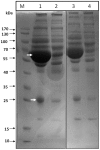An insight into the changes in human plasma proteome on adaptation to hypobaric hypoxia
- PMID: 23844025
- PMCID: PMC3699623
- DOI: 10.1371/journal.pone.0067548
An insight into the changes in human plasma proteome on adaptation to hypobaric hypoxia
Abstract
Adaptation to hypobaric hypoxia is required by animals and human in several physiological and pathological situations. Hypobaric hypoxia is a pathophysiological condition triggering redox status disturbances of cell organization leading, via oxidative stress, to proteins, lipids, and DNA damage. Identifying the molecular variables playing key roles in this process would be of paramount importance to shed light on the mechanisms known to counteract the negative effects of oxygen lack. To obtain a molecular signature, changes in the plasma proteome were studied by using proteomic approach. To enrich the low-abundance proteins in human plasma, two highly abundant proteins, albumin and IgG, were first removed. By comparing the plasma proteins of high altitude natives with those of a normal control group, several proteins with a significant alteration were found. The up-regulated proteins were identified as vitamin D-binding protein, hemopexin, alpha-1-antitrypsin, haptoglobin β-chain, apolipoprotein A1, transthyretin and hemoglobin beta chain. The down-regulated proteins were transferrin, complement C3, serum amyloid, complement component 4A and plasma retinol binding protein. Among these proteins, the alterations of transthyretin and transferrin were further confirmed by ELISA and Western blotting analysis. Since all the up- and down- regulated proteins identified above are well-known inflammation inhibitors and play a positive anti-inflammatory role, these results show that there is some adaptive mechanism that sustains the inflammation balance in high altitude natives exposed to hypobaric hypoxia.
Conflict of interest statement
Figures






Similar articles
-
Alterations of Human Plasma Proteome Profile on Adaptation to High-Altitude Hypobaric Hypoxia.J Proteome Res. 2019 May 3;18(5):2021-2031. doi: 10.1021/acs.jproteome.8b00911. Epub 2019 Apr 3. J Proteome Res. 2019. PMID: 30908922
-
Abundance of plasma antioxidant proteins confers tolerance to acute hypobaric hypoxia exposure.High Alt Med Biol. 2013 Sep;14(3):289-97. doi: 10.1089/ham.2012.1095. High Alt Med Biol. 2013. PMID: 24067188 Free PMC article.
-
Proteomic identification of novel differentiation plasma protein markers in hypobaric hypoxia-induced rat model.PLoS One. 2014 May 19;9(5):e98027. doi: 10.1371/journal.pone.0098027. eCollection 2014. PLoS One. 2014. PMID: 24842778 Free PMC article.
-
Lungs at high-altitude: genomic insights into hypoxic responses.J Appl Physiol (1985). 2015 Jul 1;119(1):1-15. doi: 10.1152/japplphysiol.00513.2014. Epub 2015 Apr 24. J Appl Physiol (1985). 2015. PMID: 25911686 Review.
-
Exposomes to Exosomes: Exosomes as Tools to Study Epigenetic Adaptive Mechanisms in High-Altitude Humans.Int J Environ Res Public Health. 2021 Aug 5;18(16):8280. doi: 10.3390/ijerph18168280. Int J Environ Res Public Health. 2021. PMID: 34444030 Free PMC article. Review.
Cited by
-
Original Research: Diametric effects of hypoxia on pathophysiology of sickle cell disease in a murine model.Exp Biol Med (Maywood). 2016 Apr;241(7):766-71. doi: 10.1177/1535370216642046. Epub 2016 Mar 29. Exp Biol Med (Maywood). 2016. PMID: 27026725 Free PMC article.
-
Time Domains of Hypoxia Responses and -Omics Insights.Front Physiol. 2022 Aug 8;13:885295. doi: 10.3389/fphys.2022.885295. eCollection 2022. Front Physiol. 2022. PMID: 36035495 Free PMC article. Review.
-
Exploratory proteomic analysis of hypobaric hypoxia and acute mountain sickness in humans.J Appl Physiol (1985). 2014 Apr 1;116(7):937-44. doi: 10.1152/japplphysiol.00362.2013. Epub 2013 Nov 21. J Appl Physiol (1985). 2014. PMID: 24265281 Free PMC article.
-
Prospect of thioredoxin as a possibly effective tool to combat OSAHS.Sleep Breath. 2023 May;27(2):421-429. doi: 10.1007/s11325-022-02640-z. Epub 2022 May 27. Sleep Breath. 2023. PMID: 35624400 Review.
-
HighAltitudeOmicsDB, an integrated resource for high-altitude associated genes and proteins, networks and semantic-similarities.Sci Rep. 2023 Jun 8;13(1):9307. doi: 10.1038/s41598-023-35792-3. Sci Rep. 2023. PMID: 37291174 Free PMC article.
References
Publication types
MeSH terms
Substances
LinkOut - more resources
Full Text Sources
Other Literature Sources
Research Materials
Miscellaneous

